 Research Conventional Submarine 1953-1972.
Research Conventional Submarine 1953-1972.Cold War US Subs
GUPPY | Barracuda class | Tang class | USS Darter | T1 class | X1 class | USS Albacore | Barbel classUSS Nautilus | USS Seawolf | Migraine class | Sailfish class | Triton class | Skate class | USS Tullibee | Skipjack class | Permit class | Sturgeon class | Los Angeles class | Seawolf class | Virginia class
Fleet Snorkel SSGs | Grayback class | USS Halibut | Georges Washington class | Ethan Allen class | Lafayette class | James Madison class | Benjamin Franklin class | Ohio class | Colombia class
The Teardrop Marvel

USS Albacore (AGSS-569) is a single prototype submarine pioneering a home-grown version of the teardrop hull shape, really starting the modern submarine shape. This revolutionary design was derived from extensive hydrodynamic and wind tunnel testing in order to reach an unprecedented underwater speed and enhance agility. USS Albacore as named was the first in US service, laid down on 15 March 1952 at Portsmouth Naval Shipyard of Kittery, Maine, launched 1 August 1953, commissioned on 6 December 1953. USS Albacore was conventionally powered at that stage when designed as nuclear powered was still in its infancy, ans so her hull shape was ported on the first time on conventional subs, the Barbel class (last and best ever in the USN), and only later on a nuclear-powered attack submarine class, the Skipjacks, and then onto its first US SSBN class, the George Washingtons a decade later. USS Albacore spent years in testing, never really integrated into the Navy in a fully operational status (reflected by her denomination), she was even unarmed and lacked proper sensors. Until her decommissioned in 1973, she tested not only hull configurations and shapes but also carried new sensors systems. Given their significance, in 1980, albeit stricken and likely to be sold for scrapped, USS Albacore was preserved. She is now close to home at Portsmouth Museum, New Hampshire. #usnavy #albacore #teardrophull #davidtaylorbasin #buships #coldwar
Development
The greatest and perhaps more decisive threat in World War II was definitively undersea warfare, as seen by many analysts of the strategic picture, as it turned the tables in the Pacific and almost did in the Atlantic. In the latter theater it urged the constitution of an escort armada like never before in history and the development of new ASW technologies and tactics. In the developing cold war in 1947, both the Soviet Union and the USN believed this would urge the design of better submarine overall to out-do the latest ASW measures. They also pointed out the more important role that they would play in coming conflicts. Even before nuclear power was out, the Type German 1944 XXI showed the way in how to streamline a hull to gain optimal performance with conventional means, but as nuclear powered was worked out in 1953 under the supervision of H. Rickover, the shaping of the hull became an even more critical goal ro reach the full potential of nuclear-powered submarines, aiming at reaching optimum submerged performance.
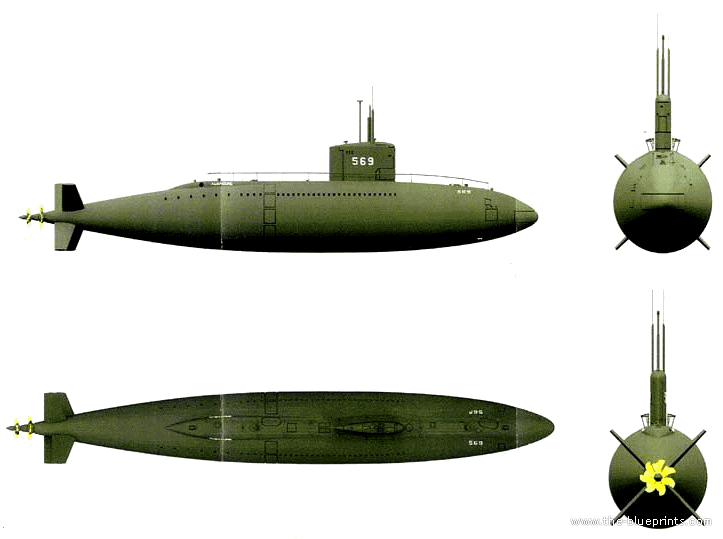
Committees in the US (and USSR as well) postwar went to the same conclusion about nuclear propulsion, highly recommended. This technology was coupled with oxygen generation and carbon dioxide removal and other breaktrhoughs enabling submarines to stay underwater for much longer. WW2 submariners were numerous to propose different schemed and soon pointed out the way towards a futuristic submarine capable of much faster speeds underwater, regardless of the powerplant. They proposed that performance characteristics were to be tested by a new generation of hydrodynamic reasearch, and by 1949 a special committee proposed such advanced hydrodynamic studies.
This led to a full program within the US Bureau of Ships (BuShips). The goal was to not improve on exiting hulls shapes, but rather to test new shapes from scratch and determine the best ratios for submerged operation. The David Taylor Model Basin in Maryland became the center for these experiments. One of such questions was the retention of twin (the usual way) or single propeller. It was not done only at the D. Taylor Model Basin but in a wind tunnel at Langley Air Force Base, Virginia, owing to recalculatiosn about the different fluidity values and properties of water compared to air.
However the way the Navy did things, in a traditional process leading to operational submarines, it looked like these were going to drag on for ever. To avoid interference from the Navy departments, Admiral Momsen proposed to shortcut the process and urged the Bureau of Ships to build a submarine usable as practice target for Anti-submarine Warfare. The design recomended was a small unarmed submarine solely usable for speed tests, which soon was determined to be single-screw, a first novelty. Given it would lack both armament and sensors it was believed to be much faster to design. Construction was authorized on 25 November 1950. The hull of the future unnamed submarine was to be built in the brand new HY-80 high-strength steel, another novelty. The latter had an unprecedented yield strength of 80,000 psi (550 MPa). This would in theory allow for unprecedented diving depth albeit it was not even registered in the initial specs.
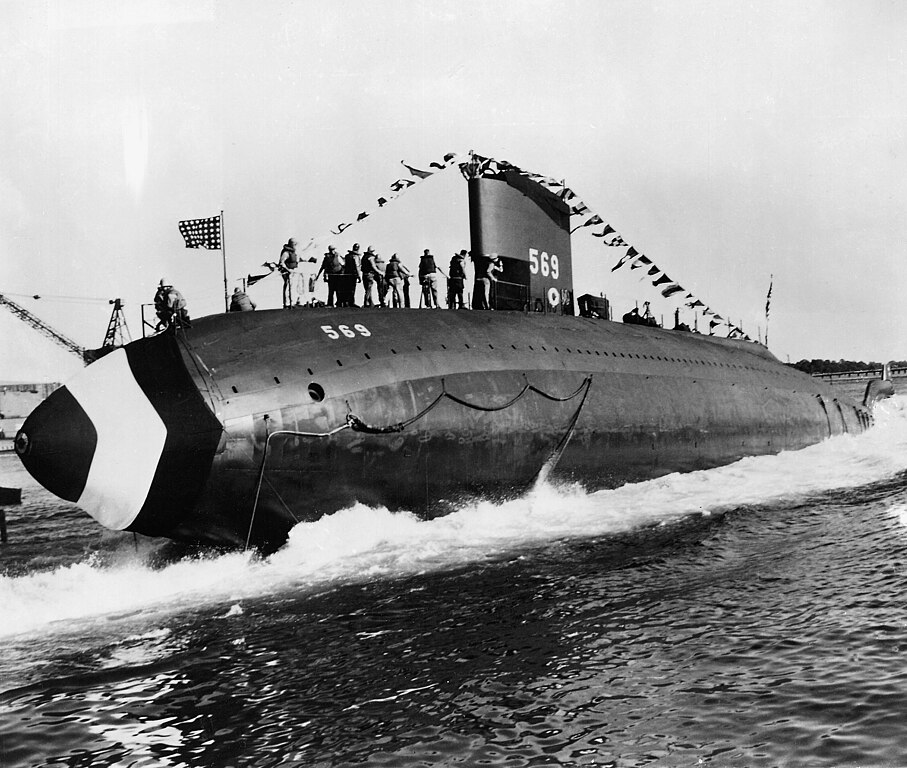
Launch in 1953. Note the shape of the roundel flag on her nose, showed the obvious slopes. Her upper forward hull was not following a strict all-arounded shaped bow but was “pinched” upwards, much narrower to present the smallest waterline entry when surfaced.
BuShips, emboldened by the proposal of a futurristic experimental sub proposed this as a bonus. This HY-80 remained standard for all steel-constructed subbmarines from the Skipjacks to the Los Angeles class in 1990. Other components such as the bulkheads and non-pressure hull would use more classic high-tensile steel (HTS). Then the final design was approved for construction and ordered as the auxiliary submarine (AGSS-569) and named Albacore on 24 November 1950, to Portsmouth Naval Shipyard of Kittery, Maine after a process of just two years, 1949-50, albeit the design was still worked out and refined when she was ultimately Laid down on 15 March 1952 and afterwards launched on August 1, 1953 at Portsmouth Naval Shipyard in Kittery, Maine, at a Cost of $20 million To compare, USS Nautilus cost was $58.2 million in 1955.
Design of the class
Hull and general design
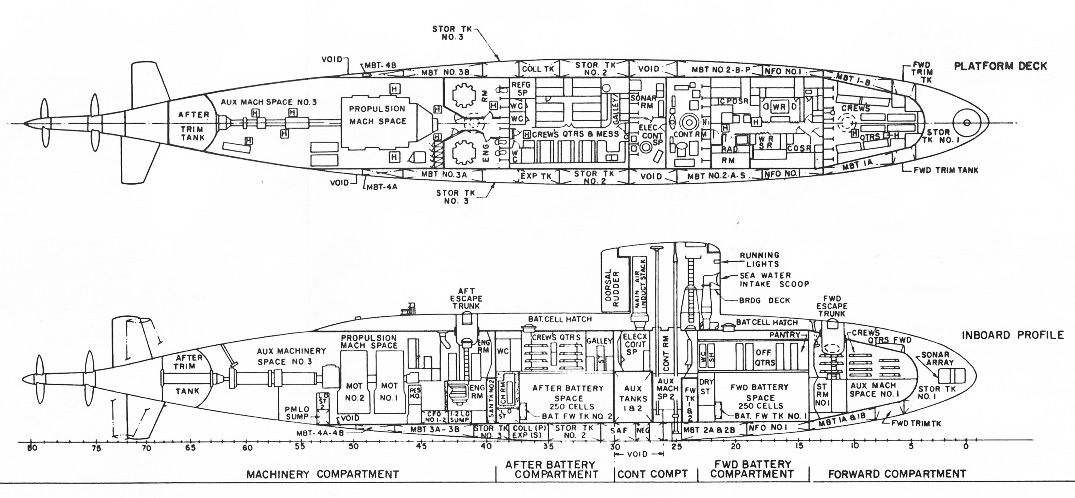
USS Albacore was not a large submarine by any stretch of imagination. Devoid of sensors or armament, much space was freed and she was reduced at the core to an utilitarian pressure hull and outer hull that could be given almost a constrains-free shape, ideal for such tests. Her size and the tech of the time did not allowed for nuclear power (USS Nautilus, laid down 14 June 1952 was 4,000 tonnes underwater !). It was found this shape would give the option to the admiralty of building conventionally powered, much enhanced submarines as nuclear power was developed. Plus a conventional power was well understood and mastered, lighter and simpler, easier to maintain given the experience available at the time.
USS Albacore was small, at 1,606.62 tons surfaced, 1,823.51 tons submerged, yet far larger than the T-1 class we saw already, also acting as target subs for ASW exercises. She was 205 ft 4.75 in (62.60 m) in overall Length for the outer hull, and between perpendiculars 200 ft (60.96 m). Her beam of 27 ft 3.75 in (8.32 m) promised a ratio of 7.33. Forward draft is 19 ft 1 in (5.82 m) and aft draft 22 ft 3 in (6.78 m). She had a small unitary (no step) conning tower (or sail) which front profile was wing-shaped but symmetrical. In section, it was rather almond than teadrop shaped.
About the teardrop shape
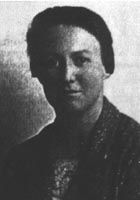 The teardrop shape had many origins, but the most direct to inspirations leading to the Albacore’s hull was from a British woman, Hilda Lyon (born 1896 in Market Weighton, Yorkshire). After WW1 when the UK government decided to develop airships, she worked on R100 at Howden and later R101 at Cardington. The main challenge was to design a minimum-drag hull already based on elliptical forms. Hilda was responsible for the aerodynamic development and later worked in many institutes and wind tunnels in Britain, Germany or the US (MIT). She passed away in 1949, too soon to see her work adapted to a submarine. This early shape was named after her. Photo: Hilda Lyons, src
The teardrop shape had many origins, but the most direct to inspirations leading to the Albacore’s hull was from a British woman, Hilda Lyon (born 1896 in Market Weighton, Yorkshire). After WW1 when the UK government decided to develop airships, she worked on R100 at Howden and later R101 at Cardington. The main challenge was to design a minimum-drag hull already based on elliptical forms. Hilda was responsible for the aerodynamic development and later worked in many institutes and wind tunnels in Britain, Germany or the US (MIT). She passed away in 1949, too soon to see her work adapted to a submarine. This early shape was named after her. Photo: Hilda Lyons, src
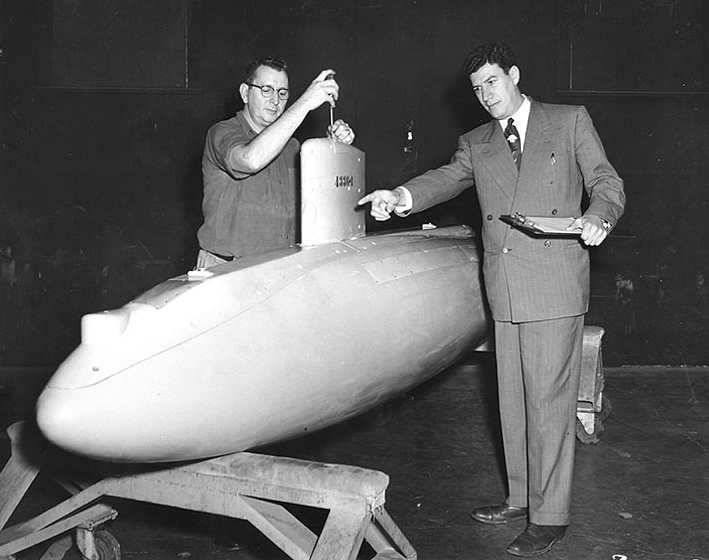
USS Albacore model in 1956 during a later configuration
Of course the major breakthrough was her “teardrop” shaped hull. It should be mentioned at that stage that until her and the Skipjack class, submarine hulls were still close to their ship style origins. Indeed, the winning design for 1910 was a “submersible torpedo boat” where surface speed and seakeeping mattered more than underwater performances. All nations went with this design, which presented distinctive feature like a central boat like flat deck and sides, standard cutting prow with no flare, and well defined bulges for the outer hull ballasts either side. These boats had deck guns, extensive conning towers with radio cable masts, platforms and structures, exhausts, and numerous filler cutouts.
All this created a lot of turbulences underwater, resistance, an noise. In 1944 Germany came out with a new type of hull taking rear concerns about underwater speed. Trials made suggested a very streamlined hull while keeping it mostly vertical. Everything was blended, rounded to reach the best hydrodynamic free flowing profile. Streamlining became the norm in postwar years, and a world’s standard before appearance of the teadrop shape which we are discussing about. This was the third evolution of submarine hull shape, and oddly enough a return to the very origins of the submarine when underwater speed mattered and hulls were clean, cigar-shaped and looking like torpedoes.
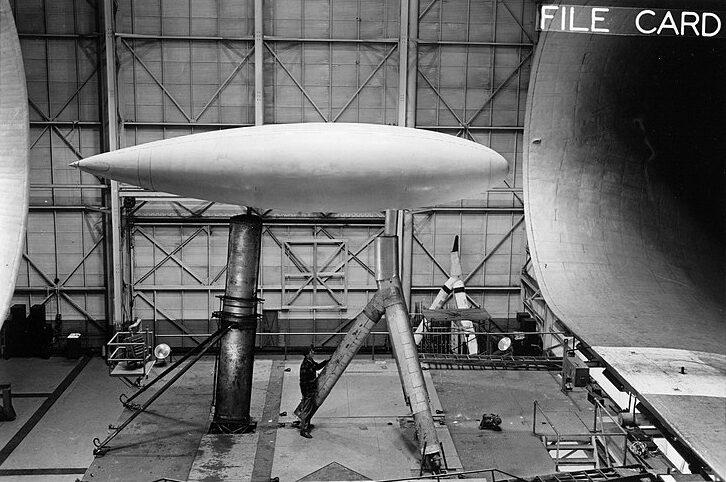
The basic shape tested at NACA: One fith model of the basic hull of the submarine Albacore, tested in the full scale windtunnel of Langley, NACA. For the data of these tests, see the NACA Research Memorendum “Data from tests of a 1/5 scale model of a proposed high-speed submarine in the Langley full-scale tunnel”, by Cocke, Lipson and Scallion.
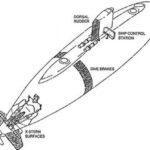 The teardrop hull concept as the name suggest borrows heavily on not only hydrodynamic science (calculating water flow and finding points of resistance) but also aerodynamics, as air and water shared a lot in common, these are similarly chemical environments, albeit differing by density, which augments as speed rose. Calculations were differents but all things compared not that far from the speed perspective between a plane at 900 kmh and beyond and a submarine at 30 knots. Levels of resistance offered were comparable, albeit air tended to heat at extreme speed, not water since the speed ratio was not reached to cause this effect. The teardrop hull was shaped as the name suggests, with a progressive rounded shape forward, then thinning down along very specific ellipses for the best flow and less turbulences. The single propeller was solely dictated by this shape, as the flow would have been disturbed by the presence of the two outer propeller structures.
The teardrop hull concept as the name suggest borrows heavily on not only hydrodynamic science (calculating water flow and finding points of resistance) but also aerodynamics, as air and water shared a lot in common, these are similarly chemical environments, albeit differing by density, which augments as speed rose. Calculations were differents but all things compared not that far from the speed perspective between a plane at 900 kmh and beyond and a submarine at 30 knots. Levels of resistance offered were comparable, albeit air tended to heat at extreme speed, not water since the speed ratio was not reached to cause this effect. The teardrop hull was shaped as the name suggests, with a progressive rounded shape forward, then thinning down along very specific ellipses for the best flow and less turbulences. The single propeller was solely dictated by this shape, as the flow would have been disturbed by the presence of the two outer propeller structures.
The only protruding elements ideally would be the sail, shaped as a wing, and four stabilizers also shaped as such. The latter was to be of greater size to stabilize and steer the boat, and that realization was inspired by aeronautics.
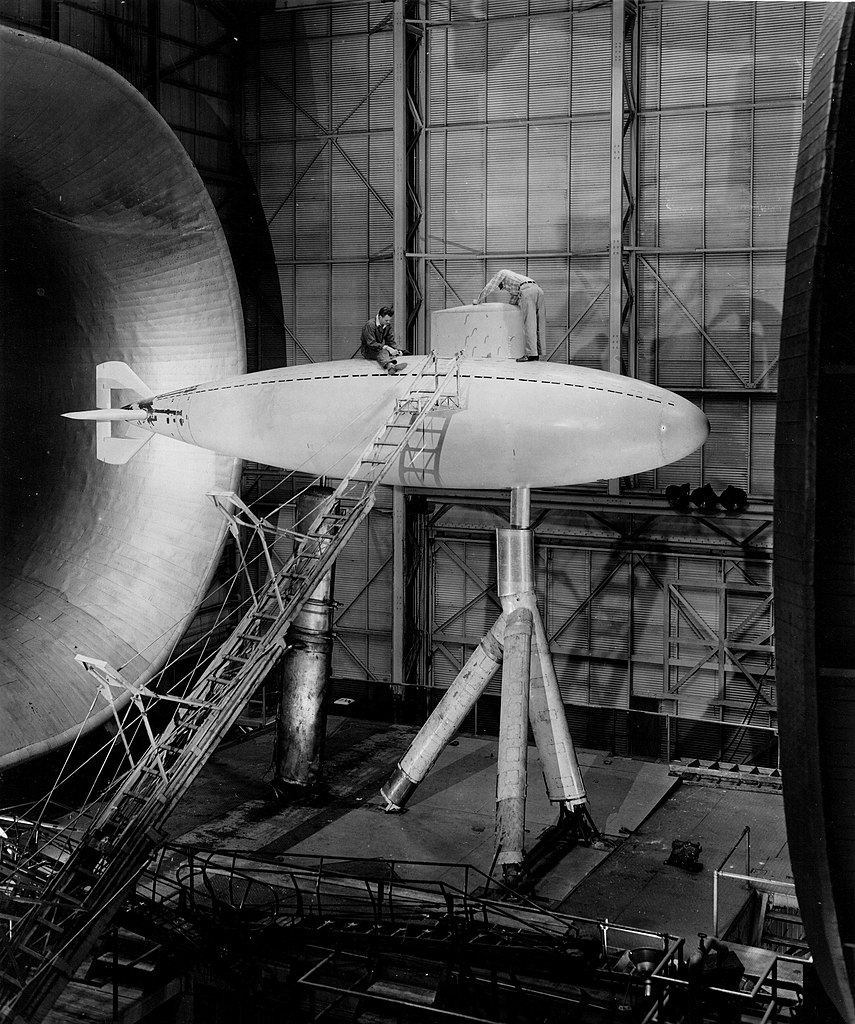
Test 196: 1/5-scale Model of High Speed Albacore Submarine; March 10, 1950
These studies benefited from a comfortable advance in aerodynamics indeed since 40 years, up to the fuselage shape of early jets in the 1950s, but also the common sense applied to the only underwater devices capable of 40+ knots at the time underwater, which were torpedoes.
All this was done without computers, with classic calculations (but with the best minds in fluid sciences), bits of wool or colored flares (in wind tunnels), and constant drawings. For the USAF, seeing a submarine taking shape in its own wind tunnel said something about the promises of nuclear power. It conversely led to efforts for creating a nuclear-powered bomber, but the winged arm would loose this battle mostly revolving around weight and crew protection, not a concern for submarines, evolving into a much greater density environment.

The Barbel’s hull shape

The Skipjack’s hull shape
USSR’s own brand of “teardrop”
It should be noted that the Soviet Union also went for a better shaped hull, realizing it would be necessary in 1950. This resulted in its first nuclear powered submarines, the Project 627 kit (November) receiving, not a “teardrop” on the strict sense but rather a rounded nose submarine. Her aft section was still classic vertical, with a profiled tail and wing-like supports for her two propellers. She was a hybrid, but far less advanced than the US design. Project 667A (Yankee) would be the first to really feature a proper “teardrop” with single propeller aft and cross tail. But it was in 1965…
Euro “teardrop”
The British were the first to implement these shapes, and HMS Dreadnought was the product of these works, not only for her hull shape but also nuclear propulsion. The French were slow to catch up, with their Redoutable SSBNs and conventional Agosta class, which had more classic prows instead of rounded. But it must be said that indeed the French were not invited in USS Albacore’s tests. They will have to wait for the 1980s to feature true teardroped submarines. The tail design was kept in most navies as a “+” and only recently the “X” was adopted, after almost 50 years, as well as propeller tunnels, which however were not tested by Albacore. In any case the 1950s “Albacore hull” is seemingly synonimous with the shape, copied by all for decades with mixed successes.
Not all navies anyway looked at this shape as perfect and it’s nowadays contested, notably given the new need for undewater sltealth, it’s likely new shapes will appear, facilitated by computer power and IA autolearning of these.

Cutaway of Albacore, Phase IV
Powerplant
USS Albacore originally was designed to house two 7,500 shp counter-rotating electric motors, powered by two 1,000 bhp (817 kW) diesel/electric generators.
Top speed, surfaced, was 25 knots and submerged speed was 33 knots as tested, but it varied greatly between configurations used, as well as range. Speed was of course paramount, but range mattered far less. It was believed that a hull with greater tank capacity would do just better while preserving this shape. But the teardrop hull by offering far less resistance was of course a powerful contributor into reducing resistance and thus, enhance range as well, as the shape would stay efficient even at lower cruise speeds. It was not evident, but that was part of calculations made. The hull shape was to be efficient at any allures.
Armament: These was none. This enabled a much faster design time and avoid complication linked to the tube openings. It should be signalled here that she was a testbed to test various propeller configurations (3, 4, 5 blades, and in the end, double 7 bladed contrarotative) as well as rudders. The final cross-shaped “X” was adopted later in phase V. In phase I she had a more classic “+” cross shaped like a torpedo tail, with attachments followed by elevons. See the tests modifications for more.
Sensors
None at first as the boat was purely experimental and geared towards speed optimision first and foremost. It was also understood that a sonar bulge would completely disrupt this efficience, and it was not realized yet how to integrate a sonar into the hull nose and relocated torpedo tubes on the sides. The Skipjack class for examplle still had torpedo tubes in the nose, and a sonar above with its own protrusion breaking the perfect rounded shape.
-In 1960, she evaluated a concave bow sonar dome, without sonar inside.
-In early 1962, she received the DIMUS sonar system.
-By late 1962 and 1963 she had the BQS-4 and BQR-2 sonars installed.
-In late 1967 she tested towed sonar arrays.
-In 1971 she calibrated and test yeat another new sonar system.
About the DIMUS System:
The aural detectability of a seven element DIMUS array for active sonar has been studied experimentally. The array was simulated with sonar data recorded at sea. It was found that a DIMUS array consisting of as few as seven elements can be effectively used. Doppler detectability is preserved. If the interference consists of reverberation from a pulse having a sinusoidal amplitude distribution, the clipping loss is about 2.5 dB for small signal‐to‐reverberation levels. This loss is independent of the bandwidth of the transmitted pulse. If the interference is local noise, the clipping loss is less than 1 dB. It was also found that when equal pulse lengths are used, the detectability of slow targets is much greater with broad‐band transmission pulses than with conventional Continuous‐wave pulses in reverberation‐limited conditions. The improvement in detection with the broad‐band pulses was preserved with DIMUS.
⚙ specifications |
|
| Displacement | 1,606.62 tons surface, 1,823.51 tons submerged |
| Dimensions | 205 ft 4.75 in x 27 ft 3.75 in x 19 ft 1 in/22 ft 3 in (62.6047 x 8.3249 x 5.82 m/6.78 m fwd/aft) |
| Propulsion | 2x 7,500 shp, counter-rotating EM, 2x 1,000 bhp/817 kW diesel/electric generators |
| Speed | Surfaced 25 knots, Submerged 33 knots |
| Range | That depends |
| Armament | None |
| Sensors | |
| Crew | 5 officers, 49 men |
Career of USS Albacore

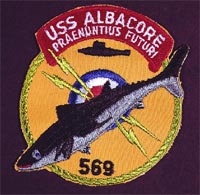 USS Albacore was commissioned on 6 December 1953 with Lieutenant Commander Kenneth C. Gummerson in command. After initial acceptance trials she left Portsmouth on 8 April 1954 for her shakedown cruise, simplified as there were just machinery qualifications and certificates to acquire. This was called “Phase I” configuration, and represented a first cycle in a rich career dedicated to scored of scientifically setup and reported experimentations before returning to her default homeport, Portsmouth, for extensive modifications in drydock (hidden from view and well guarded).
USS Albacore was commissioned on 6 December 1953 with Lieutenant Commander Kenneth C. Gummerson in command. After initial acceptance trials she left Portsmouth on 8 April 1954 for her shakedown cruise, simplified as there were just machinery qualifications and certificates to acquire. This was called “Phase I” configuration, and represented a first cycle in a rich career dedicated to scored of scientifically setup and reported experimentations before returning to her default homeport, Portsmouth, for extensive modifications in drydock (hidden from view and well guarded).
Phase I and II
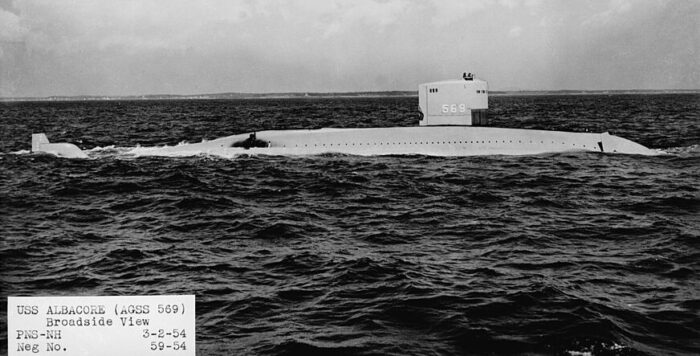
All this time she tested different design concepts aimled at providing the navy its absolute best hull configuration for future nuclear-powered or conventional submarines. She sailed off New London in Connecticut to Key West in Florida and further south in Cuban waters. It was important to test indeed the hull in cold and warm waters as density was not the same.
Back to Portsmouth on 3 July after a year at sea with engineers from the David Taylor Model Basin, she started a serie of modifications to tacked the issues observed. But an announcement was made already, that with half power than a modernized, streamlined Guppy-type submarines she was just as fast. This camed like a bombshell in the Navy top brass (there were still many “old guard” skeptics) and justified further funding.
She departed Portsmouth on 12 October 1955 for her second test cruise, via Block Island to Key West on 19 October 1955. There, she started her new role as target for antisubmarine warfare evaluations at the Operational Development Force’s Surface Antisubmarine Development Detachment. On 4 November 1955 she hosted Admiral Arleigh Burke, CNO (Chief of Naval Operations) of the USN at the time for a brief demonstration cruise with Lord Mountbatten, which reported US progressed to the british admiralty, driving the RN’s own foray into the teardrop concept. On 19 November 1955, she sailed to the Bahamas where for classified operations until 24 November 1955 and back.
From December 1955 to March 1956 she was in drydock to see her stern changed, from “torpedo style” to amore simple, refined shape. Until then, the single propeller was surrounded by the rudder and stern plane control surfaces but the new tail earned her the nickname “blimp”. This was PHASE II.
She was at sea testing this configuration by April 1956 until the end of the year. In May she diverted to visit New York City taking part in TV production Wide, Wide World, submerging with some of the TV crew aboard and an underwater camera mounted on her forecastle for a live telecast of a sub diving. In November 1956 she had her first engine conversion. Once done she left for New London on 11 March 1957, then San Juan, Puerto Rico, and Cuba then back to Boston on 2 April 1957 and finally Portsmouth in 1958 for an overhaul between April and June.
Phase III was about sound reduction. Her hull was to be partially coated with Aqua-Plas, a new sound-damping elastic compound applied to her superstructure and tank interiors. In October 1958, her bow planes were removed. She made a teste run to Halifax in Nova Scotia and back, used as target for Canadian warships.
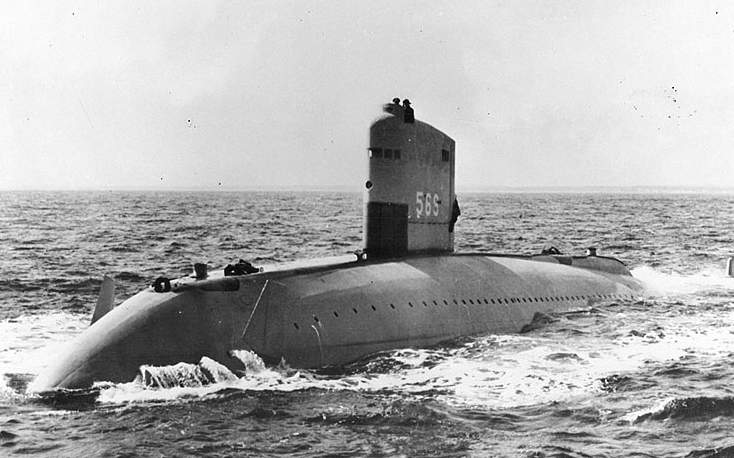
In 1959 she received a brand new 14-foot propeller and she made a run to southern waters, British West Indies in May-June, Key West as target for the ASW Development Detachment and back. In 1959-1960 she made tests for the David Taylor Model Basin team, featuring notably a new unsual bow sonar dome.
At that stage enough experience was already translated into the Barbel-class, three built on a very close design, albeit larger, USS Blueback (SS-581) being now a musem ship.
On 21 November 1960, she was back in Portsmouth drydock for her most extreme overhaul, receiving her trademark X-shaped tail and ten dive brakes around her hull plus a new bow with modified forward ballast tanks and new sonar cap, plus a large auxiliary rudder aft of her sail, which now truly was used as a vertical tail. This was not repeated however. She left the drydock on August 1961, for a serie of east coast runs and generating wealth of data.
In 1962, she received the new experimental DIMUS sonar system.
Phase III and IV
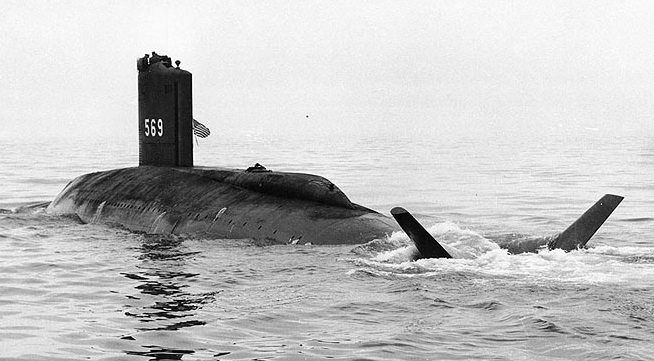
By 7 December 1962 Phase III commenced. She received a pair of concentric contra-rotating propellers. In the engine room, she collected a new high-capacity silver-zinc battery, and larger main motor for ibcreased performances. She also received a modernradio equipment as well as the BQS-4 and BQR-2 sonars to test interferences causes by the new hull, as well as an emergency recovery system, new main ballast tank blow system.
This was allo completed by March 1965, after whch she sailed to Florida, establishing a world record speed submerged. She was back on 8 October 1965 and continued evaluations.
Phase IV commenced in March 1965 and she was constantly improved until February 1970. On 1 August 1966, she was back in drydock, for her silver-zinc battery replaced and narrowing her contra-rotating propellers, done by August 1967. She had her aft pressure hull enlarged, surrounding ballast tanks eliminated for her two main propulsion motors.
She trialled these changes on the Gulf of Maine in September and for the first time tested a new type of towed sonar arrays off Port Everglades in Florida (October-November) and acoustic trials in the “Tongue of the Ocean” (a deep channel in the Central Bahamas).
On 1 January 1968, she was in Portsmouth for PHASE IV, her propulsion system was modified until 19 April. There was a month of trials in the Gulf of Maine and then off Florida to test her MONOB I and AUTEC systems as well as a Fly-Around-Body (FAB) Phase I system in the Bahamas. Back to Portsmouth on 24 August 1968, AUTEC was retired and she received FAB Phase II. After he usual tests in the Gulf of Maine, she sailed to Portsmouth on 30 September but was inactivated, waiting for further studies to urge another modification.
She remained mostly inactive until 2 February 1970 and started an overhaul for Project SURPASS: This was research the use of polymer mixed with fresh water in order to reduce water resistance, inspired by shark’s skin. Thus was sponsored by the Naval Ship Research and Development Center at Carderock in Maryland. This was Phase V which lasted between April 1971 to September 1972 and her Bow and amidships received polymer ejection manifolds. Her sail received seawater intake scoop, all for SURPASS.
She was completed by 16 April 1971 with sea trials commencing on 22 July 1971 until August 1971, proving the coating had indeed an effect on speed. By October she calibrated her sonar off Provincetown, Massachusetts.
Phase V and unrealized Phase VI, decommission
However what doomed her was her initiall trusted powerplant. The now worn out original diesel engines went into a cycle of failures which delayed operations and deployments. Project SURPASS because of this was ultimately canceled, and she was scheduled for deactivation until fitted with the new General Motors EMD 16-338 lightweight “pancake” engine, which troubles were not known yet. They had also been used on the Tang-class but proved even more siappointing. Alas, they were cannibalized to maintain her original diesels. But problems persisted and she was decommissioned as no parts were left available for her engines.
She had to undergo an unrealized sixth phase, due to these engine issues.
Phase VI comprised her hull lengthened 12-feet to accommodate the larger and seemingly more reliable Pancake diesels, but this was dropped later.
By 1971 indeed, the USN had its pinnacle achievement, the Los Angeles class, and this was thanks to all what was learned by USS Albacore and improved on her successors. Yet, the USN did not built a pure nuclear powered equivalent of AGSS-569. If there is one, it is top secret.
She saw a retirement ceremony at Portsmouth on 1 September 1972, Rear Admiral J. Edward Snyder being present, on behalf of Assistant Secretary of the Navy for Research and Development, and stating this was a submarine “that gave its body to science.” Official decommission was sactioned on 9 December 1972 and she was laid up at the Naval Inactive Ship Maintenance Facility, Philadelphia Naval Shipyard. She was however not stricken before 1st May 1980.
USS Albacore as a Museum
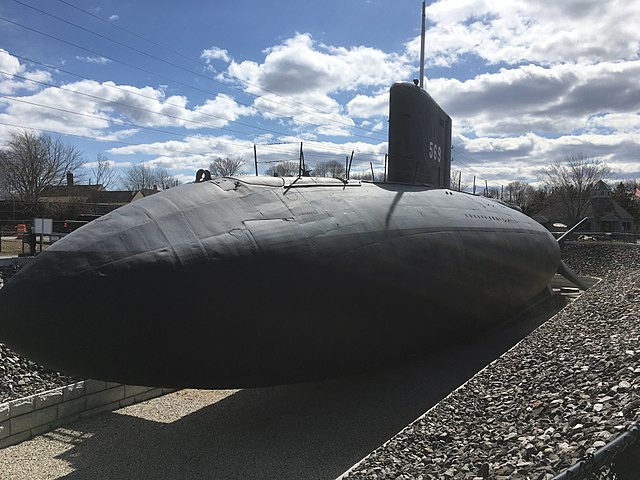
Non-profit group “Portsmouth Submarine Memorial Association” was formed to preserve her in a permanent display on dry land to allow her innovative hull to be visible. She was towed back to Portsmouth Naval Shipyard by April 1984 over 575 miles and by May 1985 entered Portsmouth Harborand her permanent display site. Fr this a railway trestle was removed, a canal dug in cut to float her through and across a four-lane road, stricking bottom on bottom railway, until a catastrophic derailment. Much work was needed until she could be brought to her resting place. After a temporary cofferdam was constructed to be re-floated she at last arrived in her permanent pre-built display cradle. She opened to the public on 30 August 1986 and is now a US historcal landmark for sciences and technology since 1989.
Her permanent address os Albacore Park, 600 Market Street, Portsmouth, New Hampshire, as part of National Register of Historic Places and by 2005 she joined WW2 sub Vet’s Submarine Hall of Fame. Her basin was reconstructed in 2016. See the link to the museum below.
Read More/Src
Books
Largess, Robert; Mandelblatt, James (2003). U.S.S. Albacore: Forerunner of the Future. Portsmouth Marine Society.
Christley, Jim; Grulich, Fred; Patterson, John (2004). “Question 18/03: Pancake Submarine Diesel Engines”. Warship International.
Polmar, Norman; Moore, K. J. (2003). Cold War Submarines: The Design and Construction of U.S. and Soviet Submarines, 1945-2001. Potomac Books.
Hunter, Jack; Jordan, Austin, eds. (2017). USS Albacore (AGSS569): An Oral History. CreateSpace Independent Publishing Platform.
“Sheraden Navy Officer Skipper of World’s Swiftest Submarine”. Pittsburgh Press. 17 March 1955.
Ryan, Cornelius (1 April 1955). “I Rode the World’s Fastest Sub”. Collier’s Weekly. pp. 25–29.
“Experimental Submarine To Be Opened to Public”. The Portsmouth Herald. Portsmouth, New Hampshire. 26 June 1956.
Soule, Gardner (December 1956). “Fastest Sub”. Popular Science. Vol. 169, no. 6. pp. 82–85, 226, 228.
“LCDR J. L. Boyes Yields Command of Submarine”. Santa Cruz Sentinel. Santa Cruz, California. 23 January 1957.
Dinan, Elizabeth (5 April 2019). “Tales from the Albacore”. seacoastonline.com.
Links
https://www.ussalbacore.org/
https://www.asme.org/about-asme/engineering-history/landmarks/209-uss-albacore
https://www.history.navy.mil/content/history/nhhc/our-collections/photography/us-people/c/caudle-carson-w/nh-97665.html
https://www.usni.org/magazines/naval-history-magazine/2023/february/super-submarine-uss-albacore
https://www.history.navy.mil/research/histories/ship-histories/danfs/a/albacore-agss-569-iii.html
https://www.nonplused.org/panos/uss_albacore/index.html
https://navsource.org/archives/08/pdf/0856948.pdf
https://www.hazegray.org/navhist/albacore.htm
https://www.navysite.de/ss/agss569.htm
https://www.history.navy.mil/research/histories/ship-histories/danfs/a/albacore-agss-569-iii.html
https://www.asme.org/about-asme/engineering-history/landmarks/209-uss-albacore
https://www.asme.org/wwwasmeorg/media/resourcefiles/aboutasme/who%20we%20are/engineering%20history/landmarks/209-uss-albacore-1953.pdf
http://www.navsource.org/archives/08/08569.htm
https://www.usni.org/magazines/naval-history-magazine/2023/february/super-submarine-uss-albacore
https://www.williammaloney.com/Aviation/USSAlbacore/index.htm
https://navy-matters.blogspot.com/2020/08/uss-albacore-and-submarine-development.html
https://web.archive.org/web/20160702123826/https://www.hnsa.org/hnsa-ships/uss-albacore-agss-569/
https://www.ussalbacore.org/historic-photos-of-the-albacore
https://en.wikipedia.org/wiki/USS_Albacore_(AGSS-569)
https://commons.wikimedia.org/wiki/Category:USS_Albacore_(AGSS-569)
https://www.navypedia.org/ships/usa/usa_submarines.htm

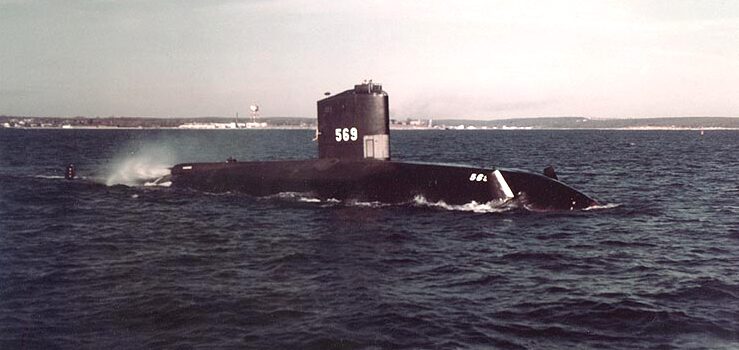



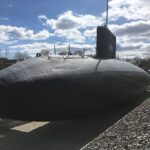
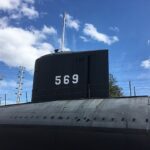
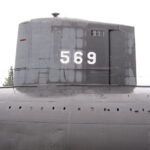
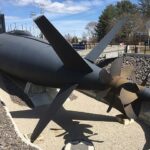
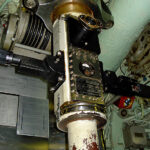
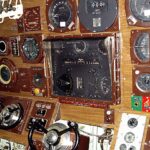
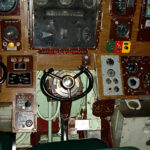
 Latest Facebook Entry -
Latest Facebook Entry -  X(Tweeter) Naval Encyclopedia's deck archive
X(Tweeter) Naval Encyclopedia's deck archive Instagram (@navalencyc)
Instagram (@navalencyc)





 French Navy
French Navy Royal Navy
Royal Navy Russian Navy
Russian Navy Armada Espanola
Armada Espanola Austrian Navy
Austrian Navy K.u.K. Kriegsmarine
K.u.K. Kriegsmarine Dansk Marine
Dansk Marine Nautiko Hellenon
Nautiko Hellenon Koninklije Marine 1870
Koninklije Marine 1870 Marinha do Brasil
Marinha do Brasil Osmanlı Donanması
Osmanlı Donanması Marina Do Peru
Marina Do Peru Marinha do Portugal
Marinha do Portugal Regia Marina 1870
Regia Marina 1870 Nihhon Kaigun 1870
Nihhon Kaigun 1870 Preußische Marine 1870
Preußische Marine 1870 Russkiy Flot 1870
Russkiy Flot 1870 Svenska marinen
Svenska marinen Søværnet
Søværnet Union Navy
Union Navy Confederate Navy
Confederate Navy Armada de Argentina
Armada de Argentina Imperial Chinese Navy
Imperial Chinese Navy Marinha do Portugal
Marinha do Portugal Mexico
Mexico Kaiserliche Marine
Kaiserliche Marine 1898 US Navy
1898 US Navy Sovietskiy Flot
Sovietskiy Flot Royal Canadian Navy
Royal Canadian Navy Royal Australian Navy
Royal Australian Navy RNZN Fleet
RNZN Fleet Chinese Navy 1937
Chinese Navy 1937 Kriegsmarine
Kriegsmarine Chilean Navy
Chilean Navy Danish Navy
Danish Navy Finnish Navy
Finnish Navy Hellenic Navy
Hellenic Navy Polish Navy
Polish Navy Romanian Navy
Romanian Navy Turkish Navy
Turkish Navy Royal Yugoslav Navy
Royal Yugoslav Navy Royal Thai Navy
Royal Thai Navy Minor Navies
Minor Navies Albania
Albania Austria
Austria Belgium
Belgium Columbia
Columbia Costa Rica
Costa Rica Cuba
Cuba Czechoslovakia
Czechoslovakia Dominican Republic
Dominican Republic Haiti
Haiti Hungary
Hungary Honduras
Honduras Estonia
Estonia Iceland
Iceland Eire
Eire Equador
Equador Iran
Iran Iraq
Iraq Latvia
Latvia Liberia
Liberia Lithuania
Lithuania Mandchukuo
Mandchukuo Morocco
Morocco Nicaragua
Nicaragua Persia
Persia San Salvador
San Salvador Sarawak
Sarawak Uruguay
Uruguay Venezuela
Venezuela Zanzibar
Zanzibar Warsaw Pact Navies
Warsaw Pact Navies Bulgaria
Bulgaria Hungary
Hungary

 Bundesmarine
Bundesmarine Dutch Navy
Dutch Navy Hellenic Navy
Hellenic Navy Marina Militare
Marina Militare Yugoslav Navy
Yugoslav Navy Chinese Navy
Chinese Navy Indian Navy
Indian Navy Indonesian Navy
Indonesian Navy JMSDF
JMSDF North Korean Navy
North Korean Navy Pakistani Navy
Pakistani Navy Philippines Navy
Philippines Navy ROKN
ROKN Rep. of Singapore Navy
Rep. of Singapore Navy Taiwanese Navy
Taiwanese Navy IDF Navy
IDF Navy Saudi Navy
Saudi Navy Royal New Zealand Navy
Royal New Zealand Navy Egyptian Navy
Egyptian Navy South African Navy
South African Navy






























 Ukrainian Navy
Ukrainian Navy dbodesign
dbodesign
Are you the Cody Sonnet i saw on quora ?
That would make sense…